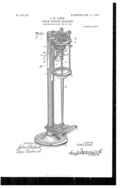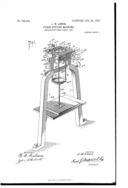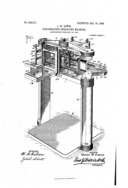There seem to have been at least three machines patented by James W. Lewis (Philadelphia).
The first of these, from 1903/1905 (US patent 787,197), is describe (in the patent) as an "improvement" to the Benton punch-cutting machine. It is clearly a modification of Benton's first style of machine. This patent was not assigned, and I do not know if the machine it describes was produced.

US Patent 787,197
US patent 787,197. "Punch-Cutting Machine." Issued 1905-04-11 to James William Lewis. Filed 1903-02-21 as application serial number 144,463.
The second machine, from 1904/1905 (US patent 798,354), also admits its Benton heritage; it appears to derive from Benton's second style of machine. The patent was not assigned, and I do not know if this machine was produced.

US Patent 798,354
US patent 798,354. "Punch-Cutting Machine." Issued 1905-08-29 to James W. Lewis. Filed 1904-06-08 as application serial number 211,649.
Lewis' third machine, from 1905/196 (US patent 839,011) was different. Also, unlike the first two machines, it is described not only as a punchcutting machine but also a matrix engraving machine. Its patent was assigned to the Keystone Type Foundry (like Lewis, this foundry was located in Philadelphia). Keystone was independent of ATF until its purchase by ATF in 1919. I have no information about whether or not Keystone actually produced this machine.
Amusingly, the patent claims the ability to cut matrices or punches from 0 to 144 points. I would very much like to see 0 point type.

US Patent 839,011
US patent 839,011. "Pantographic Engraving-Machine." Issued 1906-12-18 to James W. Lewis. Filed 1905-11-27 as application serial number 289,215.
All portions of this document not noted otherwise are Copyright © 2012, 2022 by David M. MacMillan.
Circuitous Root is a Registered Trademark of David M. MacMillan.
This work is licensed under the Creative Commons "Attribution - ShareAlike" license, version 4.0 International. See http://creativecommons.org/licenses/by-sa/4.0/ for its terms.
Presented originally by Circuitous Root®